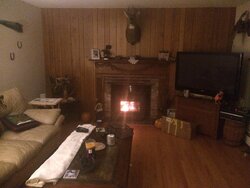A few months ago I posted up on my intent to purchase a Drolet 1800i to install in our fireplace. Since then I poked around at a few wood stove stores to compare pricing. The Drolet 1800i package (stove, surround and stainless flex liner kit) was $1600 shipped to my house. One particular store we went to in New Hampshire had nice stoves but the most comparable one to the Drolet was (at their "discounted rate") $2800 to load it in my truck. It was a Lopi stove of comparable size for $1700, flex liner at $700 and surround kit at $400. Biggest downfall there besides the much higher cost was there was no blower included and that stove would only take a 18" log versus the 20" log of the Drolet.
So for me, the Drolet was a no brainer. The blower is a very nice feature. I originally had the surround kit on but we actually like the look a lot better without it(doesn't add to the rustic look at all).
The flexible chimney liner seemed of adequate durability and I hope to get 10 years+ out of it. At the top of the chimney is a plate/cap think that has a hole at each corner. They recommended using high temp silicone to seal that to the top of the clay flue to effectively seal off the fireplace chimney and prevent heat from being sucked out of the house. I put 1 long masonry screw through each of the corner holes to secure the plate/cap to the chimney. Finally there is a rain cap that gets fastened to the top of the liner.
Installing the liner was a bit of a task. I found out in quick order that I had to remove the fireplace damper which came out relatively easy with a 4lbs sledge. I saved that in the unlikely case we ever wanted to convert back to a open fireplace but that's very unlikely.
The Drolet 1800i is not the most fancy stove on the market but it is certainly a good quality unit. It burns very nicely and is a pleasure to watch. It is going to heat my cape cod style house. Primary heating is hot water baseboard with an oil boiler but this stove should be going most of the time.
Since this picture was taken the stainless liner was painted black with high temp stove paint where it was visible to make it look better.

So for me, the Drolet was a no brainer. The blower is a very nice feature. I originally had the surround kit on but we actually like the look a lot better without it(doesn't add to the rustic look at all).
The flexible chimney liner seemed of adequate durability and I hope to get 10 years+ out of it. At the top of the chimney is a plate/cap think that has a hole at each corner. They recommended using high temp silicone to seal that to the top of the clay flue to effectively seal off the fireplace chimney and prevent heat from being sucked out of the house. I put 1 long masonry screw through each of the corner holes to secure the plate/cap to the chimney. Finally there is a rain cap that gets fastened to the top of the liner.
Installing the liner was a bit of a task. I found out in quick order that I had to remove the fireplace damper which came out relatively easy with a 4lbs sledge. I saved that in the unlikely case we ever wanted to convert back to a open fireplace but that's very unlikely.
The Drolet 1800i is not the most fancy stove on the market but it is certainly a good quality unit. It burns very nicely and is a pleasure to watch. It is going to heat my cape cod style house. Primary heating is hot water baseboard with an oil boiler but this stove should be going most of the time.
Since this picture was taken the stainless liner was painted black with high temp stove paint where it was visible to make it look better.

Last edited by a moderator:

